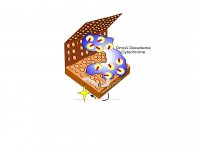Pacific Northwest National Laboratory scientists first to measure electrical charge shuttled by proteins removed from living cells
RICHLAND, Wash. – Proteins keep cells humming. Some are enzymes that taxi electrons to chemicals outside the cell, to discharge excess energy generated during metabolism. This maintains energy flow in the cell and, in turn, keeps the cell alive.
The process has worked a little like that slogan for a hyper-electrified desert gambling town: What happens in the cellular environs stays there.
Now, scientists for the first time have observed this electricity-shuttling process taking place sans cells, in purified proteins removed from the outer membrane of the versatile, metal-altering soil bacterium Shewanella oneidensis. Reporting in the current advance online edition of the Journal of the American Chemical Society, they suggest that proteins rendered portable from the organisms that spawned them could make miniature bioreactor cells feasible.
"We show that you can directly transfer electrons to a mineral using a purified protein, and I don't think anyone had shown that before," said Thomas Squier, senior author and lab fellow at the Department of Energy's Pacific Northwest National Laboratory.
The feat is the bacterial equivalent of removing lungs and coaxing the disembodied tissue to breathe.
Squier and principal authors Yijia Xiong and Liang Shi, PNNL staff scientists, discovered that the proteins, outer membrane c-type cytochrome A, or OmcA, formed a dense coating on the iron-rich mineral hematite. The metal in the mineral acts as an "acceptor," or dumping point, for thousands of trillions of electrons per square centimeter shuttled by the OmcA-donor. The function is a relic of respiration, in which the cell depends on the protein to dump electrons to maintain a steady flow of energy and prevent the organism-damaging accumulation of electrons.
PNNL staff scientist and co-author Uljana Mayer devised new tagging methods that enabled the team to isolate sufficient amounts of protein. The tags also allowed fast measurements of protein-mineral binding.
The researchers supplied the protein with energy--directly as electrons or in the form of a natural cellular fuel called NADH--and only during binding detected charge-transfer from protein to mineral, through a combination of techniques that included FCS, or fluorescent correlation spectroscopy, and confocal microscopy. These yielded a "fluorescence intensity trace" whose brightness depended entirely on whether hematite was available to bind with OmcA in solution. No hematite, dim; hematite, bright.
How bright?
"The peak current, or flux, doesn't run long, just a few seconds," Squier said, "but flux is at least as good as what you would find in the most efficient bioreactors, which rely on living bacteria."
Biological fuel cells, or biofuel cells, are not yet powerful enough to be commercially viable but they offer the promise of breaking down sewage and other biological waste while generating electricity directly from the same process. An example, Squier said, is a self-powering sewage treatment plant.
Using pure protein opens up the possibility of shrinking biofuel cells to power small electronic devices, Squier said. Whole-organism biofuel cells require engineers to design a space-adding membrane that prevents unwanted reactions between fuel, the charge-transporting agent and the electron-accepting metal, the latter being the electrode that carries the electricity to the device. In purified protein fuel cells, the seal made by the protein coating on the electrode effectively acts in place of the membrane. ###
Squier and colleagues performed the work with a team at PNNL and colleagues at the PNNL-based W.R. Wiley Environmental Molecular Sciences Laboratory biogeochemistry grand challenges program.
PNNL is a DOE Office of Science laboratory that solves complex problems in energy, national security, the environment and life sciences by advancing the understanding of physics, chemistry, biology and computation. PNNL employs 4,200 staff, has a $725 million annual budget, and has been managed by Ohio-based Battelle since the lab's inception in 1965.
Contact: Bill Cannon cannon@pnl.gov 509-375-3732 DOE/Pacific Northwest National Laboratory
 | DIGG THIS STORY |
Technorati Tags: nanofibers or Nanoscientists and Nano or Nanotechnology and nanoparticles or Nanotech and nanotubes or nanochemistry and nanoscale or nanowires and Nanocantilevers or nanometrology and nanostructure or fuel cell and Biofuel cells or Shewanella oneidensis
RELATED: Keywords Nanotech, science, Sunday, October 15, 2006 Fuel Cell Material Advance Nanocomposite, Friday, October 13, 2006 Molecular spintronic action confirmed in nanostructure (Grow Your own Spaceship), Sunday, October 08, 2006 active nanoscale surfaces for biological separations, Wednesday, October 04, 2006 Nanotechnology Podcast, Saturday, September 30, 2006 Einstein's magnetic effect is measured on microscale, Sunday, September 24, 2006 Nanocar inventor named top nanotech innovator, Thursday, September 21, 2006 scientists tame tricky carbon nanotubes, Sunday, September 17, 2006 Double Quantum Dots Control Kondo Effect, Saturday, September 16, 2006 Biodegradable napkin, featuring nanofibers, may detect biohazards, Friday, September 08, 2006 Nanoscientists Create Biological Switch from Spinach Molecule, Sunday, September 03, 2006 Sugar metabolism tracked in living plant tissues, in real time,















No comments:
Post a Comment